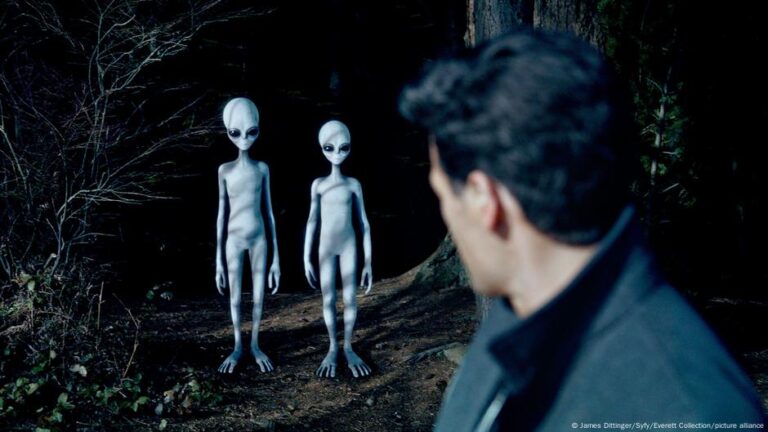What springs to mind at the mention of “alien”?
Little green men with antennae in silver suits? Grey-skinned, orb-eyed beings? Brightly lit UFOs hovering in the sky?
For social and political scientist, Christian Peters, the evolution of alien imagery in pop culture has reflected an amalgam of eyewitness accounts, cultural discourse, and media coverage.
Why grey skin and flying saucers?
Peters, the managing director of Bremen University’s International Graduate School of Social Sciences, explains how the little-green-men and silver-suit alien tropes of the 1950s were succeeded by the grey extraterrestials that also feature in today’s emoji-verse.
He cites the example of “Communion: A True Story” (1987), the bestseller in which horror author Whitley Strieber describes his alleged alien encounters — the book was later made into a film starring Christopher Walken.
“The book’s cover featured the now-iconic grey face — the kind seen by people who’ve claimed to have had abduction experiences or first contact events [with aliens],” he tells DW.
The media, too, has helped cement enduring alien visions. In 1947, pilot Kenneth Arnold described nine shiny objects darting across the sky near Mount Rainier, saying they moved “like saucers skipping across water.” Perhaps for brevity, the press described the craft as saucer-shaped — and thus the term “flying saucer” was born. The image stuck, shaping decades of UFO iconography.
Today, any object or phenomenon in the air, sea, or space that defies immediate explanation is termed a UAP — unidentified anomalous phenomenon.
Once dismissed as fringe, UAPs have steadily gained traction. The first European UAP symposium will happen in late-October in Italy, bringing together scientists and policymakers to explore the “reality and ramifications” of extraterrestrial life.
Between invaders and empaths: A timeline of alien tropes
The lack of definitive proof that otherwordly life forces exist has given filmmakers creative licence when portraying aliens, and an ability to use them as shorthand for shifting social anxieties.
In the 1950s, Cold War paranoia shaped films like “Invasion of the Body Snatchers” (1956), where aliens were widely interpreted as communist infiltrators. By the late 1970s and 80s, the focus turned to corporate exploitation and ecological dread.
In Ridley Scott’s sci-fi film “Alien” (1979), a profit-driven company plots to produce weapons using the biological makeup of a murderous alien who preys on the company’s human employees.
Steven Spielberg’s “E.T.” (1982) softened the trope, presenting the alien as a gentle outsider seeking connection. Meanwhile, in the 90s, the wildly successful television series “The X Files” suggested a conspiracy whereby a group of human elites and race of extraterrestrials seek to colonize and enslave humankind. The series catchphrase, “The truth is out there,” evokes the power of the paranormal.
After 9/11, the remake of H.G.Wells’ “War of the Worlds” (2005) reimagined alien invasion as a sudden catastrophe causing trauma and displacement.
More recent films such as “Arrival” (2016) and “Nope” (2022) were more introspective, exploring grief, language, and our obsession with spectacle.
While many alien sci-fi films have been US-centric, the Peter Jackson-produced “District 9” (2009) reimagined aliens as refugees who are discriminated against in segregated South African slums. Meanwhile, the Hindi film “Koi… Mil Gaya” (2003) explores social exclusion and acceptance via the friendship of an alien and a neurodivergent human.
Same but different?
Curiously, in most depictions or films, many of these extraterrestrials walk upright, have eyes and limbs, and emote enough for humans to understand them.
This anthropocentric tendency to see and interpret through a human lens was evident in the grotesque Xenomorph of “Alien” fame, a creature inspired by H.R. Giger’s surrealist painting, “Necronom IV.”
“It’s bipedal, it’s got eyes, a mouth, ears,” says Christian Peters. “You wouldn’t say it’s human, but it’s some sort of a demonic interpretation of earthly nature — the ultimate predator we could conceive.”
The ‘others’ among us
The word “alien” predates science fiction. Coming from the Latin “alienus,” it means “belonging to another,” “foreign,” or “strange.” An alien can also be someone who is not a citizen or national.
In many countries, the word evokes exclusion, suspicion, and otherness, especially in the context of current debates on migration and integration.
In 2021, the Biden administration in the US had proposed replacing “alien” with the less dehumanizing term “noncitizen.” But the US Immigration and Customs Enforcement (ICE) officially reinstated the use of “alien” and “alienage” in January this year.
Christian Peters draws parallels with colonialism and the impact of dominant cultures upon others.
“That’s the story of the United States at this moment, and many European societies as well,” he said. “There is a defense of cultural patterns, and distinctions, and identities that of course, transports in the idea of the ‘alien’.”
AI: An alien of our making?
Finally, artificial intelligence (AI) — non-human, non-biological, and often described as a kind of alien mind — is reshaping life as we’ve known it. As Harvard professor Chris Dede said in a 2023 interview with TechTrends about the likes of GBT AI chatbots: “AI is not a weak form of human intelligence. It is an alien intelligence.”
Agreeing that “AI is very alien,” Christian Peters adds, “the way that the technology that we have invented actually comes to the end that it produces, that’s a historically new situation that has never existed before.”
As AI systems become more complex and harder to interpret, they evoke unease — not unlike the prospect of extraterrestrials, migrants or other perceived outsiders. Perhaps this discomfort stems not from what these “others” are, but from how little we truly understand about them.
Edited by: Stuart Braun


